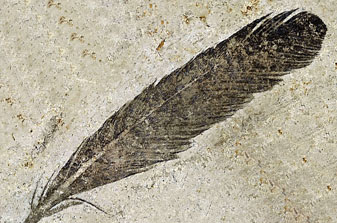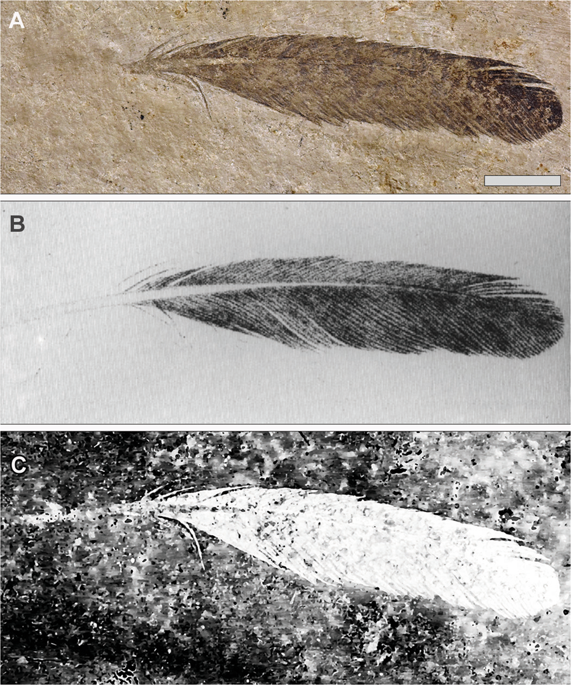Iconic Feather Fossil Did Not Belong to Archaeopteryx
Single Feather Not From Archaeopteryx
One of the most significant fossils to have ever been found, an iconic fossil in vertebrate palaeontology – a single fossilised feather from the Upper Jurassic Solnhofen limestone, is not quite what it seems. The feather, long thought to be from an Archaeopteryx, is probably not from the “urvogel” at all. The feather most likely was lost by a dinosaur, before it was blown into a shallow, calm lagoon and preserved as a carbonised film for 150 million years.
The Iconic Single Feather Fossil – Once Synonymous with Archaeopteryx is Not What it Seems

An international research team which included Dr Michael Pittman (University of Hong Kong), have applied a novel, high-tech, imaging method called Laser-Stimulated Fluorescence (LSF), to help solve a 150-year-old mystery and to confirm that this feather was not from Archaeopteryx.
Discovered in 1861
The specimen was discovered in 1861 and actually consists of a slab and counter slab component, housed in museums located in Berlin and Munich. A year later, the fossil feather was formally described and heralded as coming from an Archaeopteryx (A. lithographica), although unlike most feather impressions associated with the dozen or so Archaeopteryx specimens known to science, this feather was preserved as a dark, carbonised film. This was the first fossil feather ever discovered and at the time fossils of Archaeopteryx were heralded as evidence of a “missing link”, supporting Darwin’s recently published theory of natural selection.
The detailed scientific description published in 1862 commented upon a rather long quill visible on the fossil, but this is unseen today. Even recent X-ray fluorescence and UV (ultraviolet), imaging studies did not end the controversy of the “missing quill”. The original existence of this quill has therefore been debated and it was unclear if the single feather represented a primary, secondary, or primary covert feather from Archaeopteryx.
Archaeopteryx
Writing in the academic journal Scientific Reports, the researchers outline their work using the LSF technology and demonstrate its potential for providing new information about extensively studied fossil specimens. The application of Laser-Stimulated Fluorescence is being developed by Thomas G Kaye of the Foundation for Scientific Advancement, Sierra Vista, Arizona (USA) and Dr Pittman.
Dr Pittman stated:
“My imaging work with Tom Kaye demonstrates that important discoveries remain to be made even in the most iconic and well-studied fossils.”
Detecting the Geochemical Presence of the Lost Quill
The application of LSF technology permitted the scientists, which included lead-author of the study Tom Kaye, to detect the geochemical halo from the rachis, matching the 1862 description.
Views of the Isolated Solnhofen Feather – Not from Archaeopteryx

Picture credit: University of Hong Kong
Not Archaeopteryx but Probably from a Feathered Dinosaur
The shape of the feather has led the researchers to discount the idea that it came from an Archaeopteryx. Instead, they conclude that it probably came from an unknown species of feathered dinosaur that lived alongside Archaeopteryx in the Solnhofen Archipelago.
Daniela Schwarz, a co-author of the scientific paper based at the Museum für Naturkunde, Berlin, commented:
“It is amazing that this new technique allows us to resolve the 150-year-old mystery of the missing quill.”
This new insight into an iconic fossil specimen also suggests that the diversity of feathered dinosaurs was likely higher in the ancient island archipelago than previously thought.
Tom Kaye added:
“The success of the LSF technique here is sure to lead to more discoveries and applications in other fields. But, you’ll have to wait and see what we find next!”
Visit the award-winning Everything Dinosaur website: Everything Dinosaur.

